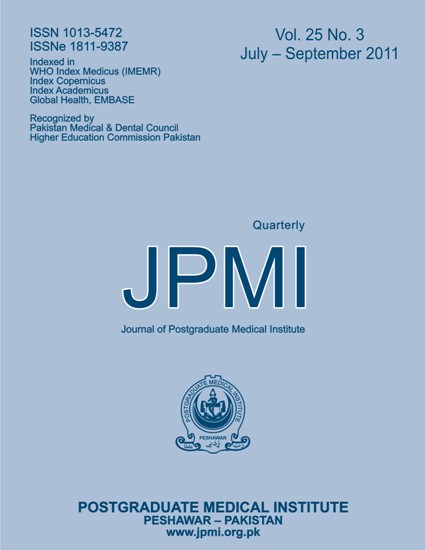PREVALENCE OF RHESUS TYPE AND ABO INCOMPATIBILITY IN JAUNDICED NEONATES
Main Article Content
Abstract
Objective: To determine the prevalence of Rh and ABO incompatibility in jaundiced neonates.Methodology: This hospital based descriptive study was conducted in Pediatrics Unit, Lady ReadingHospital Peshawar. A total of 200 neonates with clinically diagnosed jaundice were included in the study.Results: Out of 200 neonates 70% were male and 30%female. Majority of neonates 99.5% age was rangedfrom 0-10 days while only 0.5% neonate was 13 days. Out of 200 neonates, the frequency of ABOincompatibilityand Rh-incompatibility in jaundiced neonates in this study was 22.5% and 12.5%respectively. Out of the remaining 65.5% cases physiological jaundice was diagnosed in 40.5% neonates,prematurity in 15% neonates and G6PD in 9.5% neonates. Among 22.5% cases of ABO incompatibilityst nd there were 16.5% males and 6% females. Majority 15% presented on 1 day of life, followed by 3% on 2rd th th and 3 day of life respectively, 1% on 4 day, 0.5% on 5 day of life.Conclusion: Out of 200 neonates presented with jaundice, prevalence of ABO-incompatibility was found tobe 22.5% followed by Rh-incompatibility 12.5%
Article Details
How to Cite
1.
Irshad M, Muhammad A, Hussain M, Khan B, Ali N, Ahmad A, et al. PREVALENCE OF RHESUS TYPE AND ABO INCOMPATIBILITY IN JAUNDICED NEONATES. J Postgrad Med Inst [Internet]. 2011 Oct. 14 [cited 2025 Dec. 13];25(3). Available from: https://jpmi.org.pk/index.php/jpmi/article/view/1167
Issue
Section
Original Article
Work published in JPMI is licensed under a
Creative Commons Attribution-NonCommercial 2.0 Generic License.
Authors are permitted and encouraged to post their work online (e.g., in institutional repositories or on their website) prior to and during the submission process, as it can lead to productive exchanges, as well as earlier and greater citation of published work.


